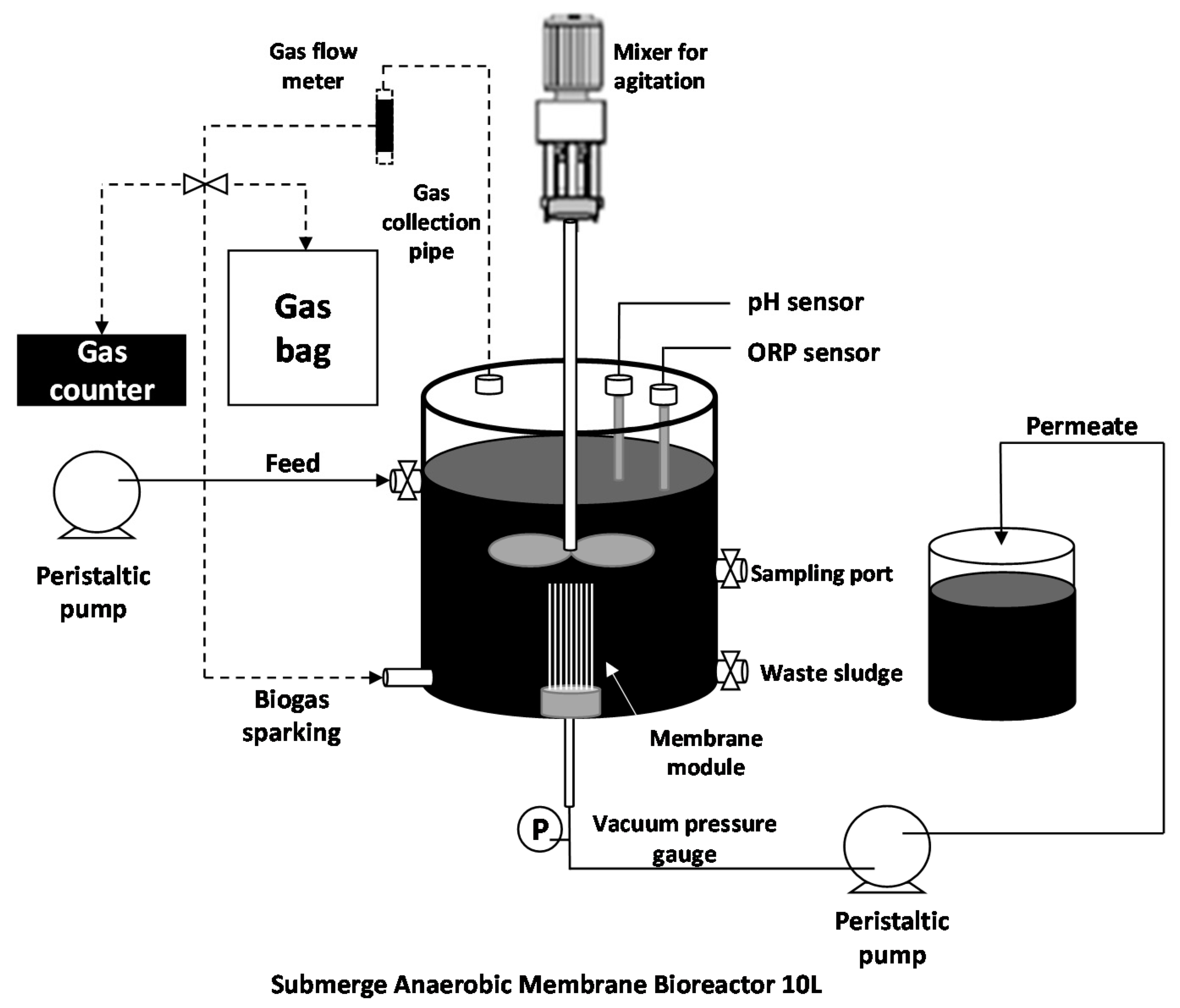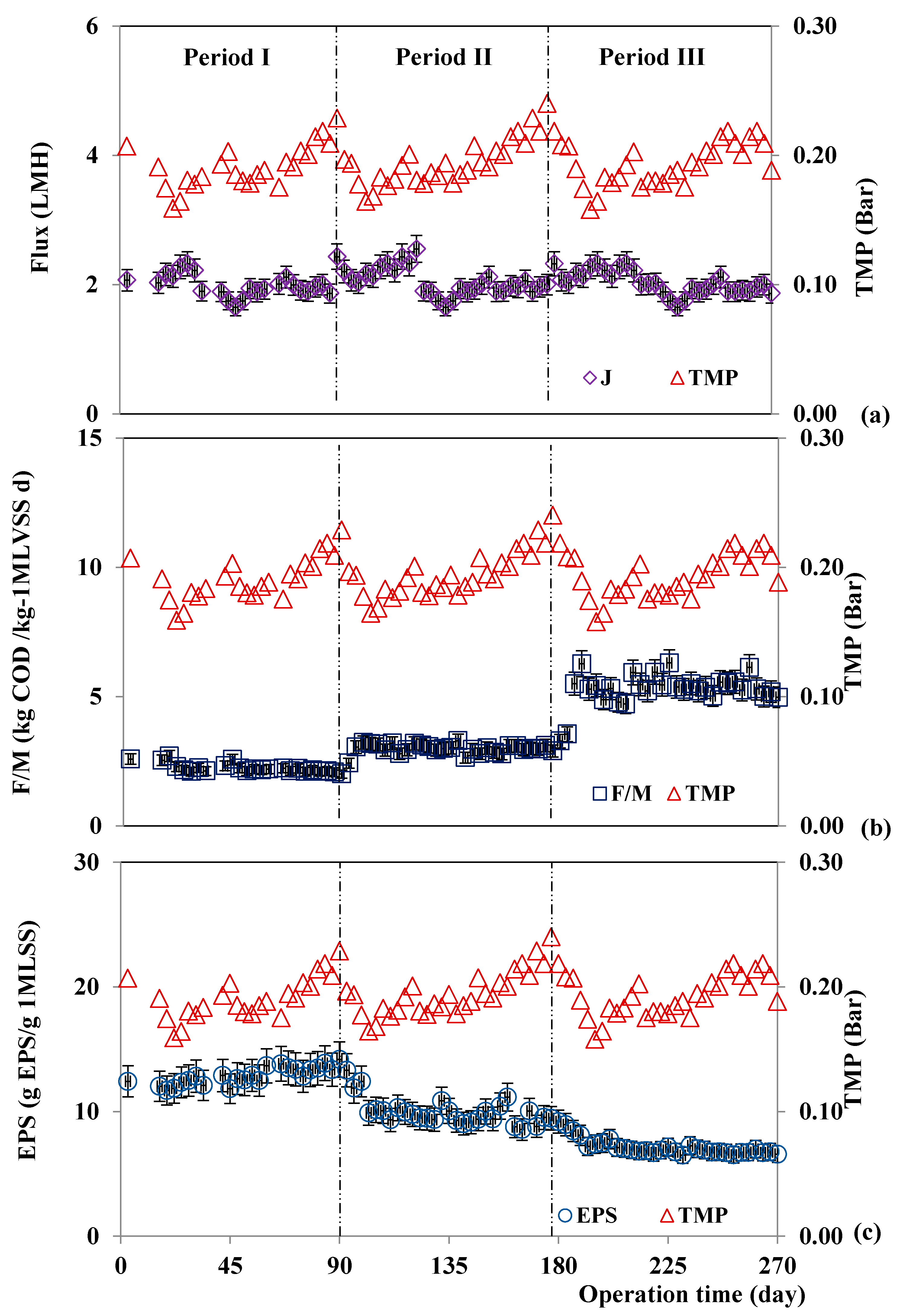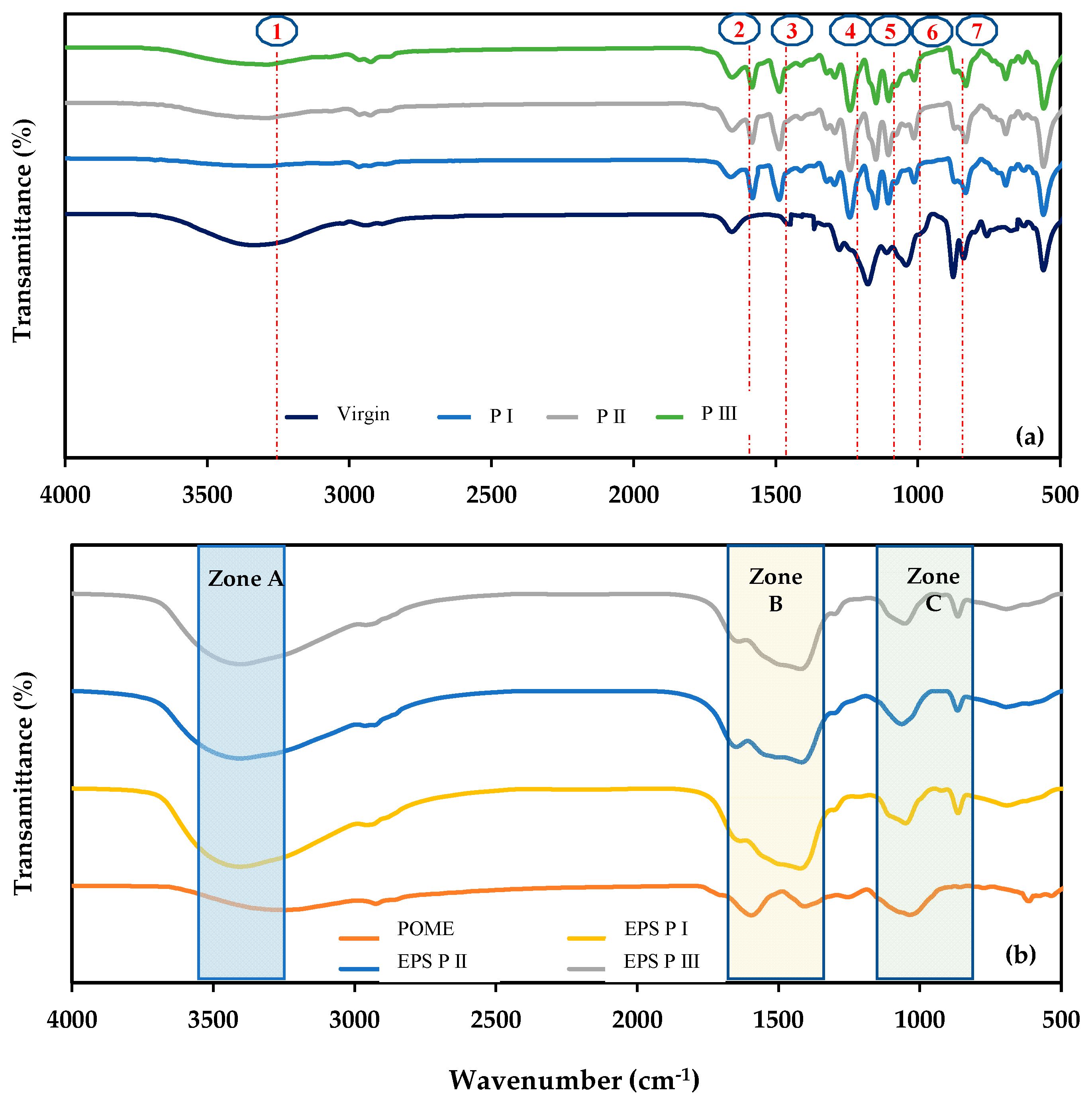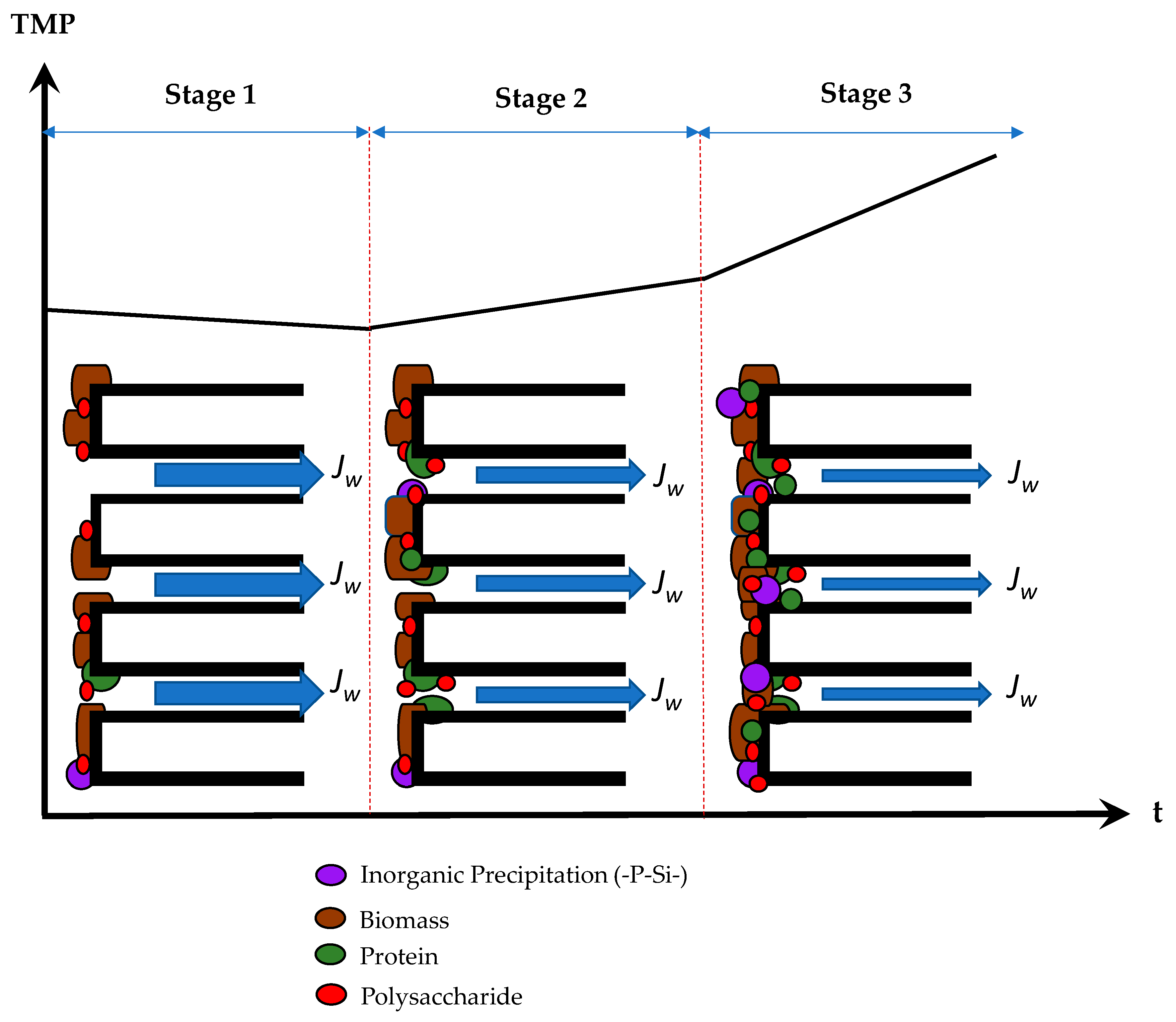Fouling Behavior in a High-Rate Anaerobic Submerged Membrane Bioreactor (AnMBR) for Palm Oil Mill Effluent (POME) Treatment
Abstract
1. Introduction
2. Materials and Methods
2.1. Materials
2.2. Membrane Production and Characteristics
2.3. Experimental Setup and Operation of Anaerobic Membrane Bioreactor (AnMBR)
2.4. Biomass Analysis
2.5. Membrane Fouling and Characterization
- Organic fouling
- Inorganic fouling
3. Results
3.1. The Relationship of Biomass and EPS
3.2. Membrane Filtration Performance
3.3. Organic Foulant
3.4. Inorganic Foulant
4. Discussion
- (1)
- Stage I: initial fouling. The TMP slightly decreased over a short period during days 1 to 20, then a rapid increase of TMP occurred. During the initial decrease of TMP, the flux increased and approached the critical flux (2.8 L/m2/h). After that, the cake layer materialized. The flux decreased and reached the local flux instead, causing the TMP to increase from 0.15 bar to 0.18 bar. The organic substances in the bulk feed were the major foulants on membrane surfaces. During this stage, the effect of foulant accumulation in the membrane pores (pore blocking) was minor.
- (2)
- Stage II: intermediate adsorption fouling. From day 20 to 70, the TMP remained constant at 0.20 bar. The cake layer was attached to the membrane surfaces, for which EPS, especially proteins, was adsorbed on the surfaces. A fraction of EPS was accumulated in the membrane pores and was entrapped there by the charge adsorption process.
- (3)
- Stage III: cake and pore blocking. Day 71 onwards, the TMP had risen to 0.25 bar. A dense cake layer accumulated at the surface, and pore blocking occurred simultaneously. In addition, adjacent to the cake layer, the bound EPS released and attached to the membrane.
5. Conclusions
- The growing cake layer, which resulted from high OLR and high MLSS, initiated biofilm formation on the membrane surfaces. The biofilm, in turn, bridged across the pores, resulting in increased TMP.
- EPS accumulated on the cake layer and, thus, plugged the membrane pores. The fouling from polysaccharide EPS can be mitigated by control of hydrodynamic conditions using internal recirculation. Due to the charge on the surfaces and the interaction between proteins and the membrane surface, the removal of protein EPS fouling was more difficult.
- The precipitation of inorganic compounds, silica, and phosphorus, also occurred in the AnMBR system. These compounds were then attached to the cake layer and caused membrane fouling.
Author Contributions
Funding
Institutional Review Board Statement
Informed Consent Statement
Data Availability Statement
Acknowledgments
Conflicts of Interest
References
- Krishnan, S.; Md Din, M.F.; Taib, S.M.; Nasrullah, M.; Sakinah, M.; Wahid, Z.A.; Kamyab, H.; Chelliapan, S.; Rezania, S.; Singh, L. Accelerated two-stage bioprocess for hydrogen and methane production from palm oil mill effluent using continuous stirred tank reactor and microbial electrolysis cell. J. Clean. Prod. 2019, 229, 84–93. [Google Scholar] [CrossRef]
- Abdulsalam, M.; Man, H.C.; Idris, A.I.; Yunos, K.F.; Abidin, Z.Z. Treatment of palm oil mill effluent using membrane bioreactor: Novel processes and their major drawbacks. Water 2018, 10, 1165. [Google Scholar] [CrossRef]
- Teng, T.T.; Wong, Y.-S.; Ong, S.-A.; Norhashimah, M.; Rafatullah, M. Start-up Operation of Anaerobic Degradation Process for Palm Oil Mill Effluent in Anaerobic Bench Scale Reactor (ABSR). Procedia Environ. Sci. 2013, 18, 442–450. [Google Scholar] [CrossRef]
- Tan, S.P.; Kong, H.F.; Bashir, M.J.K.; Lo, P.K.; Ho, C.D.; Ng, C.A. Treatment of palm oil mill effluent using combination system of microbial fuel cell and anaerobic membrane bioreactor. Bioresour. Technol. 2017, 245, 916–924. [Google Scholar] [CrossRef] [PubMed]
- Aziz, N.I.H.A.; Hanafiah, M.M. the Potential of Palm Oil Mill Effluent (Pome) as a Renewable Energy Source. Acta Sci. Malaysia 2017, 1, 9–11. [Google Scholar] [CrossRef]
- Cheng, H.; Li, Y.Y.Y.; Guo, G.; Zhang, T.; Qin, Y.; Hao, T.; Li, Y.Y.Y. Advanced methanogenic performance and fouling mechanism investigation of a high-solid anaerobic membrane bioreactor (AnMBR) for the co-digestion of food waste and sewage sludge. Water Res. 2020, 187, 116436. [Google Scholar] [CrossRef] [PubMed]
- Balcıoğlu, G.; Yilmaz, G.; Gönder, Z.B. Evaluation of anaerobic membrane bioreactor (AnMBR) treating confectionery wastewater at long-term operation under different organic loading rates: Performance and membrane fouling. Chem. Eng. J. 2021, 404, 126261. [Google Scholar] [CrossRef]
- Li, L.; Kong, Z.; Xue, Y.; Wang, T.; Kato, H.; Li, Y.Y. A comparative long-term operation using up-flow anaerobic sludge blanket (UASB) and anaerobic membrane bioreactor (AnMBR) for the upgrading of anaerobic treatment of N, N-dimethylformamide-containing wastewater. Sci. Total Environ. 2020, 699, 134370. [Google Scholar] [CrossRef]
- Cerón-Vivas, A.; Kalboussi, N.; Morgan-Sagastume, J.M.; Harmand, J.; Noyola, A. Model assessment of the prevailing fouling mechanisms in a submerged membrane anaerobic reactor treating low-strength wastewater. Bioresour. Technol. 2018, 268, 460–469. [Google Scholar] [CrossRef]
- Maaz, M.; Yasin, M.; Aslam, M.; Kumar, G.; Atabani, A.E.; Idrees, M.; Anjum, F.; Jamil, F.; Ahmad, R.; Khan, A.L.; et al. Anaerobic membrane bioreactors for wastewater treatment: Novel configurations, fouling control and energy considerations. Bioresour. Technol. 2019, 283, 358–372. [Google Scholar] [CrossRef]
- Ruigómez, I.; González, E.; Guerra, S.; Rodríguez-Gómez, L.E.; Vera, L. Evaluation of a novel physical cleaning strategy based on HF membrane rotation during the backwashing/relaxation phases for anaerobic submerged MBR. J. Memb. Sci. 2017, 526, 181–190. [Google Scholar] [CrossRef]
- Poojamnong, K.; Tungsudjawong, K.; Khongnakorn, W.; Jutaporn, P. Characterization of reversible and irreversible foulants in membrane bioreactor (MBR) for eucalyptus pulp and paper mill wastewater treatment using fluorescence regional integration. J. Environ. Chem. Eng. 2020, 8, 104231. [Google Scholar] [CrossRef]
- Kaya, Y.; Bacaksiz, A.M.; Bayrak, H.; Vergili, I.; Gönder, Z.B.; Hasar, H.; Yilmaz, G. Investigation of membrane fouling in an anaerobic membrane bioreactor (AnMBR) treating pharmaceutical wastewater. J. Water Process Eng. 2019, 31, 100822. [Google Scholar] [CrossRef]
- Chen, R.; Nie, Y.; Hu, Y.; Miao, R.; Utashiro, T.; Li, Q.; Xu, M.; Li, Y.Y. Fouling behaviour of soluble microbial products and extracellular polymeric substances in a submerged anaerobic membrane bioreactor treating low-strength wastewater at room temperature. J. Memb. Sci. 2017, 531, 1–9. [Google Scholar] [CrossRef]
- Foglia, A.; Akyol, Ç.; Frison, N.; Katsou, E.; Eusebi, A.L.; Fatone, F. Long-term operation of a pilot-scale anaerobic membrane bioreactor (AnMBR) treating high salinity low loaded municipal wastewater in real environment. Sep. Purif. Technol. 2020, 236, 116279. [Google Scholar] [CrossRef]
- Anjum, F.; Khan, I.M.; Kim, J.; Aslam, M.; Blandin, G.; Heran, M.; Lesage, G. Trends and progress in AnMBR for domestic wastewater treatment and their impacts on process efficiency and membrane fouling. Environ. Technol. Innov. 2020, 21, 101204. [Google Scholar] [CrossRef]
- Burman, I.; Sinha, A. Anaerobic hybrid membrane bioreactor for treatment of synthetic leachate: Impact of organic loading rate and sludge fractions on membrane fouling. Waste Manag. 2020, 108, 41–50. [Google Scholar] [CrossRef]
- Ye, L.; Xia, T.; Chen, H.; Ling, L.; Xu, X.; Alvarez, P.J.J.; Zhu, L. Effect of bamboo charcoal amendment on an AnMBR in the aspect of anaerobic habitat and membrane fouling. Environ. Sci. Water Res. Technol. 2018, 4, 2058–2069. [Google Scholar] [CrossRef]
- APHA; AWWA; WEF. Standard Methods for examination of water and wastewater. APHA, AWWA, WEF. Standard Methods Exam. Water Wastewater 2012. [Google Scholar] [CrossRef]
- Bae, J.; Shin, C.; Lee, E.; Kim, J.; McCarty, P.L. Anaerobic treatment of low-strength wastewater: A comparison between single and staged anaerobic fluidized bed membrane bioreactors. Bioresour. Technol. 2014, 165, 75–80. [Google Scholar] [CrossRef]
- Li, Z.; Tian, Y.; Ding, Y.; Wang, H.; Chen, L. Contribution of extracellular polymeric substances (EPS) and their subfractions to the sludge aggregation in membrane bioreactor coupled with worm reactor. Bioresour. Technol. 2013, 144, 328–336. [Google Scholar] [CrossRef]
- Lowry, O.H.; Rosebrough, N.J.; Farr, A.L.; Randall, R.J. Protein measurement with the Folin phenol reagent. J. Biol. Chem. 1951, 193, 265–275. [Google Scholar] [CrossRef]
- Dubois, M.; Gilles, K.A.; Hamilton, J.K.; Rebers, P.A.; Smith, F. Colorimetric Method for Determination of Sugars and Related Substances. Anal. Chem. 1956, 28, 350–356. [Google Scholar] [CrossRef]
- Sun, F.Y.; Wang, X.M.; Li, X.Y. Visualisation and characterisation of biopolymer clusters in a submerged membrane bioreactor. J. Memb. Sci. 2008, 325, 691–697. [Google Scholar] [CrossRef][Green Version]
- Matar, G.; Gonzalez-Gil, G.; Maab, H.; Nunes, S.; Le-Clech, P.; Vrouwenvelder, J.; Saikaly, P.E. Temporal changes in extracellular polymeric substances on hydrophobic and hydrophilic membrane surfaces in a submerged membrane bioreactor. Water Res. 2016, 95, 27–38. [Google Scholar] [CrossRef]
- Chen, L.; Cheng, P.; Ye, L.; Chen, H.; Xu, X.; Zhu, L. Biological performance and fouling mitigation in the biochar-amended anaerobic membrane bioreactor (AnMBR) treating pharmaceutical wastewater. Bioresour. Technol. 2020, 302. [Google Scholar] [CrossRef]
- Zhang, Z.; Qiu, J.; Xiang, R.; Yu, H.; Xu, X.; Zhu, L. Organic loading rate (OLR) regulation for enhancement of aerobic sludge granulation: Role of key microorganism and their function. Sci. Total Environ. 2019, 653, 630–637. [Google Scholar] [CrossRef] [PubMed]
- Cheng, H.; Hiro, Y.; Hojo, T.; Li, Y.Y. Upgrading methane fermentation of food waste by using a hollow fiber type anaerobic membrane bioreactor. Bioresour. Technol. 2018, 267, 386–394. [Google Scholar] [CrossRef]
- Santos, F.S.; Ricci, B.C.; França Neta, L.S.; Amaral, M.C.S. Sugarcane vinasse treatment by two-stage anaerobic membrane bioreactor: Effect of hydraulic retention time on changes in efficiency, biogas production and membrane fouling. Bioresour. Technol. 2017, 245, 342–350. [Google Scholar] [CrossRef]
- Liu, Y.; Liu, H.; Cui, L.; Zhang, K. The ratio of food-to-microorganism (F/M) on membrane fouling of anaerobic membrane bioreactors treating low-strength wastewater. Desalination 2012, 297, 97–103. [Google Scholar] [CrossRef]
- Khongnakorn, W.; Wisniewski, C. Membrane fouling and physical characteristics of sludge in MBR system. Desalin. Water Treat. 2010, 18, 235–238. [Google Scholar] [CrossRef]
- Wandera, S.M.; Qiao, W.; Jiang, M.; Gapani, D.E.; Bi, S.; Dong, R. AnMBR as alternative to conventional CSTR to achieve efficient methane production from thermal hydrolyzed sludge at short HRTs. Energy 2018, 159, 588–598. [Google Scholar] [CrossRef]
- Tsui, T.H.; Chen, L.; Hao, T.; Chen, G.H. A super high-rate sulfidogenic system for saline sewage treatment. Water Res. 2016, 104, 147–155. [Google Scholar] [CrossRef]
- Tsui, T.H.; Ekama, G.A.; Chen, G.H. Quantitative characterization and analysis of granule transformations: Role of intermittent gas sparging in a super high-rate anaerobic system. Water Res. 2018, 139, 177–186. [Google Scholar] [CrossRef] [PubMed]
- Singh, K.; Devi, S.; Bajaj, H.C.; Ingole, P.; Choudhari, J.; Bhrambhatt, H. Optical Resolution of Racemic Mixtures of Amino Acids through Nanofiltration Membrane Process. Sep. Sci. Technol. 2014, 49, 2630–2641. [Google Scholar] [CrossRef]
- Huzir, N.M.; Aziz, M.M.A.; Ismail, S.B.; Mahmood, N.A.N.; Umor, N.A.; Faua’ad Syed Muhammad, S.A. Optimization of coagulation-flocculation process for the palm oil mill effluent treatment by using rice husk ash. Ind. Crops Prod. 2019, 139, 111482. [Google Scholar] [CrossRef]
- Baharuddin, A.S.; Rahman, N.A.A.; Shah, U.K.M.; Hassan, M.A.; Wakisaka, M.; Shirai, Y. Evaluation of pressed shredded empty fruit bunch (EFB)-palm oil mill effluent (POME) anaerobic sludge based compost using fourier transform infrared (FTIR) and nuclear magnetic resonance (NMR) analysis. Afr. J. Biotechnol. 2011, 10, 8082–8089. [Google Scholar] [CrossRef]
- Ng, K.H.; Cheng, Y.W.; Lee, Z.S.; Cheng, C.K. A study into syngas production from catalytic steam reforming of palm oil mill effluent (POME): A new treatment approach. Int. J. Hydrog. Energy 2019, 20900–20913. [Google Scholar] [CrossRef]
- Bao, P.; Xia, M.; Liu, A.; Wang, M.; Shen, L.; Yu, R.; Liu, Y.; Li, J.; Wu, X.; Fang, C.; et al. Extracellular polymeric substances (EPS) secreted by: Purpureocillium lilacinum strain Y3 promote biosynthesis of jarosite. RSC Adv. 2018, 8, 22635–22642. [Google Scholar] [CrossRef]
- Ni, T.; Ge, Q. Highly hydrophilic thin-film composition forward osmosis (FO) membranes functionalized with aniline sulfonate/bisulfonate for desalination. J. Memb. Sci. 2018, 564, 732–741. [Google Scholar] [CrossRef]
- Ding, Y.; Tian, Y.; Li, Z.; Zuo, W.; Zhang, J. A comprehensive study into fouling properties of extracellular polymeric substance (EPS) extracted from bulk sludge and cake sludge in a mesophilic anaerobic membrane bioreactor. Bioresour. Technol. 2015, 192, 105–114. [Google Scholar] [CrossRef] [PubMed]








| Parameter | pH | Temp. | TCOD | SCOD | TS | VS | SS | VSS |
|---|---|---|---|---|---|---|---|---|
| (°C) | (g/L) | (g/L) | (g/L) | (g/L) | (g/L) | (g/L) | ||
| Pretreated POME | 5.11 | 35 | 242 | 107 | 18.5 | 10.3 | 8.9 | 3.2 |
| Period | OLR (kgCOD/m3 × d) | HRT (d) | EPS (mg/g MLVSS) | CLSM Thickness (µm) | TMP Rate (bar/d) | |||
|---|---|---|---|---|---|---|---|---|
| Polysaccharide | Protein | C/P | Polysaccharide | Protein | ||||
| I | 43 | 13 | 3.26 ± 0.13 | 11.91 ± 0.77 | 0.27 | 10.16 ± 2.33 | 10.74 ± 2.91 | 0.191 ± 0.017 |
| II | 57 | 10 | 2.41 ± 0.25 | 8.57 ± 0.94 | 0.28 | 15.34 ± 2.97 | 17.52 ± 3.99 | 0.195 ± 0.017 |
| III | 99 | 6 | 1.58 ± 0.17 | 5.99 ± 0.66 | 0.26 | 16.24 ± 2.74 | 157.56 ± 81.46 | 0.192 ± 0.016 |
| Sample | Wavelength (cm−1) |
|---|---|
| POME | 3246, 1597, 1408, 1255, 1036, 610–870 |
| Virgin membrane | 3288, 2964, 1584, 1244, 1115, 832, 558 |
| Fouled membrane | 1638, 1400, 1231, 1040, 864 |
| EPS | 3285, 1638, 1400, 1231, 1040, 864 |
Publisher’s Note: MDPI stays neutral with regard to jurisdictional claims in published maps and institutional affiliations. |
© 2021 by the authors. Licensee MDPI, Basel, Switzerland. This article is an open access article distributed under the terms and conditions of the Creative Commons Attribution (CC BY) license (https://creativecommons.org/licenses/by/4.0/).
Share and Cite
Chaipetch, W.; Jaiyu, A.; Jutaporn, P.; Heran, M.; Khongnakorn, W. Fouling Behavior in a High-Rate Anaerobic Submerged Membrane Bioreactor (AnMBR) for Palm Oil Mill Effluent (POME) Treatment. Membranes 2021, 11, 649. https://doi.org/10.3390/membranes11090649
Chaipetch W, Jaiyu A, Jutaporn P, Heran M, Khongnakorn W. Fouling Behavior in a High-Rate Anaerobic Submerged Membrane Bioreactor (AnMBR) for Palm Oil Mill Effluent (POME) Treatment. Membranes. 2021; 11(9):649. https://doi.org/10.3390/membranes11090649
Chicago/Turabian StyleChaipetch, Wiparat, Arisa Jaiyu, Panitan Jutaporn, Marc Heran, and Watsa Khongnakorn. 2021. "Fouling Behavior in a High-Rate Anaerobic Submerged Membrane Bioreactor (AnMBR) for Palm Oil Mill Effluent (POME) Treatment" Membranes 11, no. 9: 649. https://doi.org/10.3390/membranes11090649
APA StyleChaipetch, W., Jaiyu, A., Jutaporn, P., Heran, M., & Khongnakorn, W. (2021). Fouling Behavior in a High-Rate Anaerobic Submerged Membrane Bioreactor (AnMBR) for Palm Oil Mill Effluent (POME) Treatment. Membranes, 11(9), 649. https://doi.org/10.3390/membranes11090649






